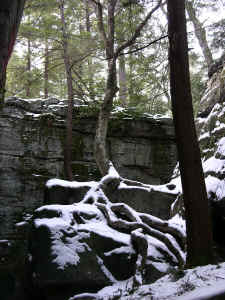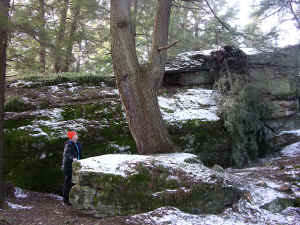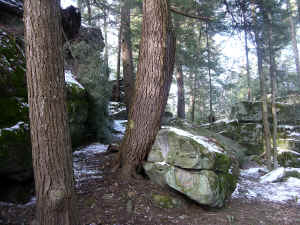|
ENTS,
Today I took a short trip to Bilger’s
Rocks near Curwensville, Clearfield
County, Pennsylvania. Bilger’s
Rocks is an impressive “rock city” consisting
of about 20 acres of large block shaped
boulders up to 50 on a side and twenty to twenty-five
feet thick. The
Bilger’s Rocks Association currently owns and cares for the
175 acre tract. The group was formed in March 1988 and with
grants, donations and fundraisers purchased the property. They
are managing the property as a community park and have made
major steps in removing trash, bottles, and graffiti from the
rock area and have installed some picnic shelters, restrooms,
and pavilions on the adjoining ridgetop. The ridgtop in the area
is capped by a massively bedded sandstone. Along the edge of the outcrop the large blocks are breaking
free along widely spaced joints and through mass wasting are
slowly creeping down the hillside.
There are narrow crevices
forming a maze between the blocks, a few short crevice
caves, and large open “rooms”
within the boulder field.

Main entrance to Bilger's Rocks |
 |
I wanted to revisit the site to examine the
trees growing among the rocks.
Most of the general surrounding area had been timbered
again and again over the years and where present the forest is
relatively young second growth. The canopy reaches an average height of about 80 feet in the
vicinity of the rocks themselves.
A brief list of species found include:
Eastern Hemlock, White Pine, Red Oak, White Oak, Red
Maple, American Beech, Cucumber Magnolia, Yellow Birch,
Rhododendron, Mountain Laurel, and a number of species I
can’t identify by the bark alone.

Stream just below
Bilger's Rocks |

Stream just below
Bilger's Rocks |
Within the rock complex itself there are
some larger trees, predominantly Eastern hemlock.
There are several hemlocks with cbh’s in the 8 to 10
foot range. These
are the largest trees found at Bilger;’s Rocks.
The area was covered in snow and ice today, so I was not
able to do the bouldering required to get accurate height
measurements. The
narrow crevices, rooms, and boulder piles in which they were
located made line of sight difficult and would require me to
measure the lower section from one location and the rest of the
tree from another. I will return when the snow is gone and climbing is better.

8 foot 7 inch cbh hemlock |

Birch atop a boulder |
I am always fascinated by trees struggling
to find a purchase on the almost bare blocks of rock, or growing
atop boulder piles on the forest floor.
The gnarled nature of the long bare roots stretching down
the rock surface to reach the soil below give the scenes a
primordial feel. Three
were masses of ferns growing from the sides and tops of the
rocks peeking out from underneath the snow cover.
Moss and lichen cover the sides of the rocks and cliffs.

Hemlock tree, 9' 4" cbh, abutting boulder |

Hemlock tree, 9' 4" cbh, abutting boulder |
One large hemlock 9’ 4” cbh was growing
tight against the side of a half buried boulder.
At a height of four feet the one side of the tree trunk
has started to bulge across the lip of the rock.
The trunk is very asymmetrical with it’s long diameter,
parallel to the boulder, twice the perpendicular
diameter where the trunk abuts the large rock.
It is certainly a site worth revisiting in warmer
weather.

Room within the "Rock City" at Bilger's
Rocks |
I want to
get heights for the largest of the hemlocks and other trees
within the rock city itself.
They are not particularly tall likely just 100 to 110
feet. While the surrounding area has been logged, I believe
these large hemlocks likely predate settlement of the area by
Europeans. What
is Old Growth? Tom Diggens speculated that two trees were enough to
constitute “Old Growth.”
By that generous definition, this is a small patch of old
growth within the heart of the rock field.
 |
The last tree a measured was a large
Hercules Club, Aralia spinosa, 27.5 feet tall, 9”
cbh, with a spread of 6 feet in a small hollow across
and just up the road from the main entrance to Bilger’s
Rocks.
There are a large number of this species growing in the
recently cut area of woods in the area.
It is possible that larger ones are present but not
measured do to lack of time.
I did not make many measurements, but got some nice
photos and enjoyed a nice afternoon in the woods. |
Here are a couple of links on the web worth
checking out:
http://www.offroaders.com/album/clearfield/clear1099/bilgers.html
http://www.offroaders.com/album/clearfield/clear1099/bilgers2.html
http://ctcnet.net/cccra/westbrrept.pdf
Ed Frank
|